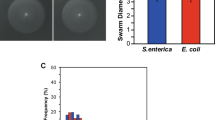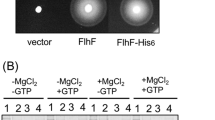Abstract.
The marine methanogen Methanococcus voltae possesses two transcriptional units that encode a total of four flagellins. Immediately downstream of the flagellin genes are a number of ORFs, some of which are cotranscribed with the flagellin genes. These putative genes have been named flaCDEFGHIJ, although no biochemical data has implicated them in flagellar morphogenesis. None of the flaC-J genes has homology to any bacterial gene, with the exception of flaI, which shows homology to pilT, a gene that encodes a nucleotide binding protein of the type IV pilus family. In this study, insertional mutations in flaH of M. voltae were identified. The mutants were non-motile and non-flagellated as determined by electron microscopy. Southern hybridization experiments confirmed the insertion of a mutagenic vector into flaH and indicated that two, tandem, copies of the vector were present. It is believed that insertion of the vector into flaH should disrupt the transcription of flaIJ due to polar effects. The flaH mutant displayed the same pattern of multiple mRNA transcripts, all originating upstream of flaB1, as the wild-type cells. Northern hybridization experiments failed to detect a flaHIJ transcript in either wild-type or mutant cells. Immunoblotting experiments indicated, however, that the mutants produced similar amounts of flagellin, FlaD and FlaE to wild-type cells. Flagellin localization experiments suggest that the flaH mutant is deficient in flagellin secretion and/or assembly. The mutant also displayed similar preflagellin peptidase activity to the wild-type cells, indicating that none of the genes flaHIJ is likely to be the gene that encodes this enzyme, which is required for cleaving the leader peptide from the preflagellins prior to their incorporation into the flagellar filament. This is the first data indicating that the flaHIJ gene cluster is essential for flagellation in methanogens.
Similar content being viewed by others
Author information
Authors and Affiliations
Additional information
Electronic Publication
Rights and permissions
About this article
Cite this article
Thomas, N., Pawson, C. & Jarrell, K. Insertional inactivation of the flaH gene in the archaeon Methanococcus voltae results in non-flagellated cells. Mol Gen Genomics 265, 596–603 (2001). https://doi.org/10.1007/s004380100451
Received:
Accepted:
Published:
Issue Date:
DOI: https://doi.org/10.1007/s004380100451




